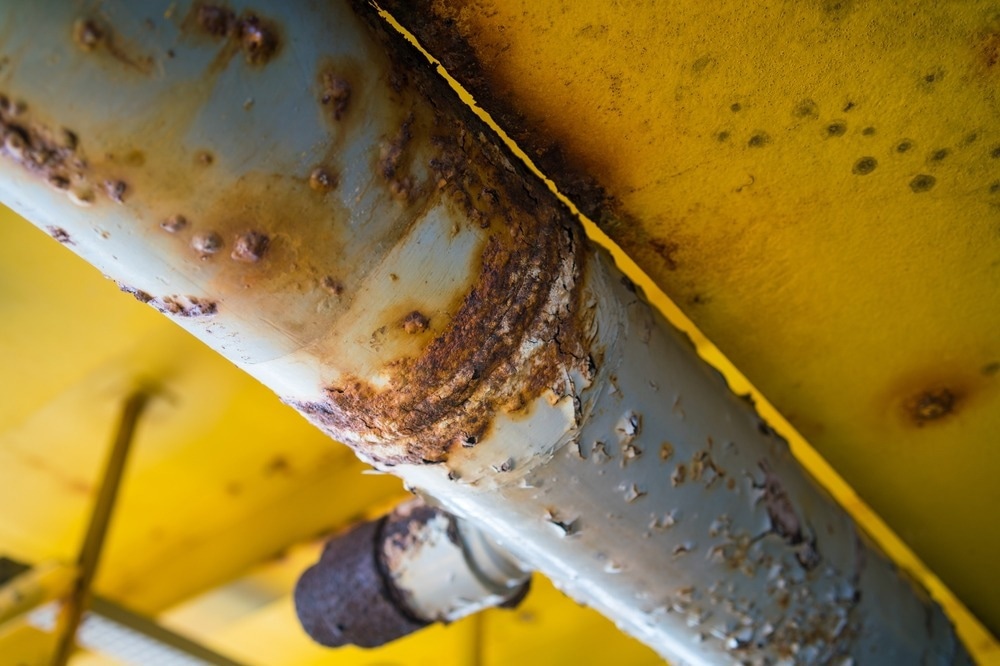In a recent article published in Polymers, researchers from China detailed the development and application of a waterborne coating containing modified nanoscale titania to protect steel structures in coastal power plants under subtropical marine climates. The aim is to enhance the coating's anticorrosion properties and evaluate its performance in extreme environmental conditions.

Image Credit: MR.Zanis/Shutterstock.com
Background
This study addresses the critical challenge of corrosion on steel structures in coastal regions exposed to subtropical marine climates. Coastal areas are particularly vulnerable to accelerated corrosion due to the presence of corrosive ions, high humidity, intense sunlight, and saltwater exposure. Traditional heavy anticorrosive coatings, such as zinc-rich coatings, often fail in these harsh environments, leading to rapid deterioration of steel structures and frequent maintenance needs.
Recently, the use of nanoscale titania (TiO2) in waterborne coatings has emerged as a promising strategy to enhance corrosion resistance and extend the service life of protective coatings. However, the tendency of nanoscale titania to agglomerate poses a challenge in maintaining the desired properties of polymeric nanocomposite coatings.
Therefore, the development of modified nanoscale titania formulations that address agglomeration issues and enhance the performance of waterborne coatings is essential for effective corrosion protection in coastal industrial settings.
The Current Study
Nanoscale titania particles were dispersed in a solution of anhydrous ethanol and deionized water at a volume ratio of 3:1. The dispersion was achieved using an ultrasonic dispersion processor for ten minutes to form a homogeneous titania suspension.
Three different silane coupling agents were mixed with deionized water at a mass ratio of 10:1. To allow hydrolysis, the pH of the solution was adjusted to 2 using acetic acid.
The titania suspension and the silane coupling agent solution were mixed and kept in an iso-temperature water bath at 40 to 100 °C. To ensure proper modification, the mixture was stirred at 500 r/min for a duration of 10 to 70 minutes.
Following the modification process, the suspension was centrifuged for 30 minutes to separate the precipitate. To remove the excess silane coupling agent, the collected precipitate was washed with ethanol. The modified titania nanoparticles were then dried at 60 °C for 6 hours and finely ground into particles.
The modified titania nanoparticles, designated as A1, A2, and A3 based on the respective silane coupling agents used, were characterized for their physical and chemical properties. Techniques such as X-ray diffraction (XRD), scanning electron microscopy (SEM), and Fourier-transform infrared spectroscopy (FTIR) were employed to analyze the structural and surface modifications.
The modified nanoscale titania particles were incorporated into a polyacrylate waterborne emulsion along with dispersant, wetting agent, and defoaming agent. The resulting waterborne anticorrosive coating was applied to steel structures in coastal power plants for field testing under subtropical marine conditions.
Results and Discussion
The field testing of the waterborne coating containing modified nanoscale titania revealed exceptional anticorrosive performance on steel structures exposed to subtropical marine conditions. After five years of exposure, covering an extensive area of 60,000 m2, the coatings showed no significant signs of failure or corrosion damage. This longevity and durability highlight the effectiveness of the modified titania nanoparticles in enhancing the protective properties of the coating.
One of the key observations from the field testing was the coating's remarkable hydrophobic ability, which contributed to its resistance against moisture and saltwater exposure. The coating maintained its integrity even under high-humidity conditions and low-derusting grade environments, showcasing its robustness in challenging maritime climates. This hydrophobic nature is crucial for preventing water ingress and corrosion initiation on steel surfaces.
The coatings with modified nanoscale titania demonstrated superior adhesion to the steel substrates, ensuring long-term protection against corrosion. The absence of coating failures or delamination after prolonged exposure indicates the structural integrity and bonding strength of the waterborne coating. This structural stability is essential for maintaining anticorrosive performance over extended periods, especially in aggressive marine environments.
The successful application of the waterborne coating with modified nanoscale titania in coastal power plants under subtropical marine climates has significant implications for industrial corrosion protection strategies. The coatings' ability to withstand harsh environmental conditions, including chemical exposure, high temperatures, and UV radiation, positions them as cost-effective and durable solutions for corrosion prevention in marine infrastructure.
Conclusion
The study successfully developed and applied a waterborne coating with modified nanoscale titania for corrosion protection in coastal power plants. The long-term field-testing results confirmed the durability and effectiveness of the coating in extreme marine climates. This innovative coating technology offers a reliable solution for industries facing corrosion challenges in similar environmental conditions, showcasing its potential for widespread application in marine infrastructure protection.
Journal Reference
Lyu. Y., et al. (2024). Anticorrosion Performance of Waterborne Coatings with Modified Nanoscale Titania under Subtropical Maritime Climate. Polymers. DOI: 10.3390/polym16131919